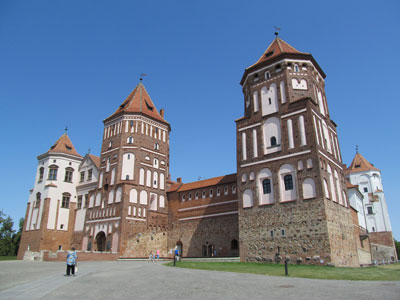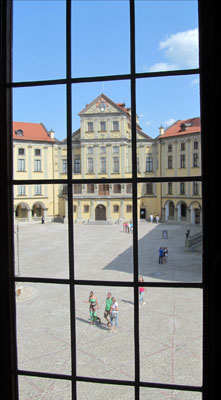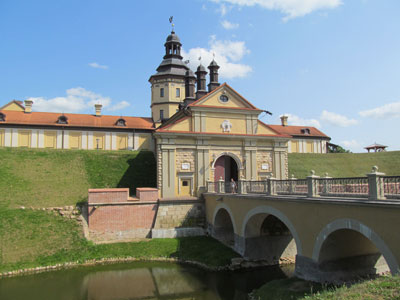Belarus’ Lithuanian heritage
This item appears on page 60 of the February 2014 issue.
(Second of two parts)
Our excursion into Belarus in July 2013 was a search for Lithuania’s past in this landlocked Eastern European country that is Lithuania’s neighbor to its south and east. My husband, Paul, and I found this past in abundance.
During the 13th to 18th centuries, Belarus was part of the vast Lithuanian empire (united with Poland for much of that time) which, at its greatest extent, stretched from the Baltic Sea to the Black Sea.
We had already visited the castles of Grodno, Lida and Novogroduk that had been built by some of the most prominent names in Lithuanian history: King Mindaugas (c. 1200-1263), Grand Duke Gediminas (c. 1275-1341) and Grand Duke Vytautas (c. 1350-1430).
Mir Castle
Thirty-two miles southeast of the sad, scanty ruins of Novogrudok lies the glorious palace of Mir. The land that Mir Castle stands on once belonged to Grand Duke Vytautas, who gave it to his brother Žygimantas Ke¸stutaitis, who, himself, became Grand Duke of Lithuania in 1432.
Mir passed eventually in the early 16th century to Yuri Ilyinich, a local magnate. It was Yuri who built the first castle there, a fortress-like structure of thick walls, towers, drawbridge and moat. Yuri’s grandson died childless and so, in 1568-1569, the castle passed into the hands of the Radvila/Radziwiłł family.
The Radvilas, a family of Lithuanian origin, rose to prominence and power in the 14th century acquiring land and properties in Lithuania, Poland and Belarus. When they acquired Mir by inheritance, they transformed it from a fortress into a splendid Renaissance palace with an Italian-style garden and an artificial lake.
This was to be their family home for almost 250 years, through the Russo-Polish War of the mid-17th century, the Great Northern War of the early 18th century, the Kos´ciuszko Uprising of 1794 and the Franco-Russian War of the early 19th century, until finally it was abandoned in 1813.
In 1891, the ruined property was sold to the Svyatopolk-Mirsky family, who owned many of the businesses in the town of Mir. They owned Mir until 1939. Restoration work began in 1982, and in 2000 it was added to the prestigious UNESCO World Heritage Sites list.
Mir is a magnificent palace, with five towers enclosing a small quadrangular courtyard. One of the towers serves as an entranceway into the palace. The façade is a blend of red brick interspersed with white sandstone — a colorful and beautiful mix.
The palace rooms are furnished to represent different periods in the castle’s history, so you will see medieval armor, a Gothic-era kitchen, mannequins garbed in 16th-century dress, Renaissance tapestries and coffered ceilings, and a 19th-century study. It all blends well and gives an idea of how the Radvilas, their predecessors and their successors lived.
Nesvizh Palace
Twenty-one miles southeast of Mir lies another Radvila palace, Nesvizh (the Lithuanians call it Nesvyžiaus), which first belonged to Lithuanian grand dukes. There is documentation of there being a town called Nesvizh in 1223, but it was only in the 16th century that it passed into the hands of the Radvilas.
In 1582, Mikolaj Krzysztof Radziwiłł began building a Renaissance-style palace on top of the preexisting medieval castle. When this palace was damaged in 1706 during the Great Northern War, the family rebuilt it in Baroque style, creating a grand complex of several buildings surrounding a large inner courtyard. An English-style park was added in the 1880s.
Entry into Nesvizh is over a stone bridge over a moat and through an impressive neoclassical gatehouse. From the courtyard with its well, visitors can explore stately rooms full of crystal chandeliers; wood-paneled rooms with walls hung with portraits of generations of Radvilas; heavy Renaissance wooden furniture, and the wonderful tall, tiled stoves used to warm rooms in wintertime.
One room houses a collection of dolls dressed richly in period costume to give visitors an idea of what people wore while living in these elegant rooms.
The Corpus Christi Church, a short walk from the palace, houses the coffins of 72 departed Radvilas. Built in the late 16th century, this church is considered one of the earliest, if not the earliest, Baroque building in Eastern Europe. Nesvizh, like Mir, is on the UNESCO World Heritage Sites list, added in 2005.
Overnight detour to Minsk
Before visiting our seventh and last castle in Belarus, we detoured 62 miles to overnight in Minsk, the capital of Belarus. Sometimes described as “grim” in guidebooks, we find it anything but.
As on a previous trip to Minsk six years before, we enjoyed strolling the main boulevard, Nezavisimosti Avenue, lined with monumental Soviet-era buildings with plenty of cafés along the way for snacks and people-watching. If you have the time, it’s worthwhile spending at least two or three nights in Minsk.
Krevo Castle
On our way back to Vilnius, 117 miles northwest of Minsk, we stopped 42 miles northwest of Minsk at Krevo Castle, located in a village just off the main Minsk-Vilnius road. This, like Novogrudok Castle, is a sad ruin of crumbling towers and walls, although here there’s much more left than at Novogrudok.
Krevo was a fortified stone castle built in the early 14th century by Grand Duke Gediminas and occupied by both him and Algirdas. Algirdas was one of Gediminas’ three sons, all of whom became Grand Dukes. Ke¸stutis, another of the three sons, was imprisoned and probably murdered in this castle in 1381 after he deposed his nephew, Grand Duke Jogaila.
Krevo Castle is best known as the place where the Union of Krevo was signed in 1385, which established a union between the Grand Duchy of Lithuania and the Kingdom of Poland. In 1386, Jogaila was baptized in Kraków, Poland, married Queen Jadwiga of Poland and was crowned King of Poland as Wladyslaw II Jagiello.
Sacked by Crimean Tatars early in the 16th century, the castle stood crumbling for the next four centuries until World War I placed it on the front line between Russians and Germans, reducing it even further to the ruins you see today.
It was there in Krevo, standing in a vast trapezoidal space now overgrown with waist-high grass and surrounded by dilapidated castle walls, that we ended our brief, 3-day foray into Lithuania’s days of glory.
A lone horse standing outside a broken-down barn beside the ruins followed our movements with curiosity as we stumbled over grass-covered hillocks inside Krevo Castle’s courtyard trying to imagine how it once must have looked.
If you go…
Our excursion of two nights and three days to Belarus was arranged by Vytis Tours (40-24 235th St., Douglaston, NY 11363; 800/778-9847), experts in Lithuania travel for over 20 years.
The cost for a private car with driver, accommodations in 4-star hotels and castle entry fees was $1,700 for the two of us — pricey, we thought, but well worth the cost.
In addition, there was a hefty Belarus visa fee of $640 for both of us (none is required for Lithuania). We paid double the fee for expedited service, even with three weeks’ lead time, because, with US and Belarusian holidays preceding the trip, we felt we might not get our visas in time for our departure.
Be aware that any border crossing between Lithuania and Belarus can be time consuming and nerve wracking. There is apparently no “average” wait time. Getting into Belarus took almost three hours. Getting out to return to Lithuania would probably have taken as long as six to eight hours, as estimated by our driver before he decided to “negotiate” switching places in the very long line of cars. It then took us less than half an hour to cross into Lithuania.



